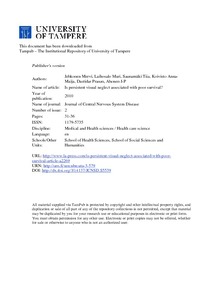Is persistent visual neglect associated with poor survival?
Jehkonen, Mervi; Laihosalo, Mari; Saunamäki, Tiia; Koivisto, Anna-Maija; Dastidar, Prasun; Ahonen, J-P (2010)
Jehkonen, Mervi
Laihosalo, Mari
Saunamäki, Tiia
Koivisto, Anna-Maija
Dastidar, Prasun
Ahonen, J-P
2010
Journal of Central Nervous System Disease 2
31-36
This publication is copyrighted. You may download, display and print it for Your own personal use. Commercial use is prohibited.
Julkaisun pysyvä osoite on
https://urn.fi/urn:nbn:uta-3-579
https://urn.fi/urn:nbn:uta-3-579
Tiivistelmä
Background: The association of visual neglect with survival after right hemisphere (RH) stroke has received only limited attention.
Objective: This study explores the relationship of visual neglect and its spontaneous recovery to survival in a homogenous patient group with first-ever RH stroke.
Methods: Fifty-one RH stroke patients who suffered an infarct between 1994 and 1997 were retrospectively followed for survival until August 31, 2009. Acute-phase neurological, neuropsychological and neuroradiological data were studied to identify predictors of survival.
Results: Twenty-eight patients died during the follow-up. Age, education, and poor recovery of visual neglect emerged as significant single predictors of death. The best set of predictors for poor survival in the multivariate model was poor recovery of visual neglect and low education.
Conclusions: Poor recovery of visual neglect is associated with long-term mortality in RH infarct patients. The follow-up of RH patients’ neuropsychological performance gives additional information about the prognosis.
Objective: This study explores the relationship of visual neglect and its spontaneous recovery to survival in a homogenous patient group with first-ever RH stroke.
Methods: Fifty-one RH stroke patients who suffered an infarct between 1994 and 1997 were retrospectively followed for survival until August 31, 2009. Acute-phase neurological, neuropsychological and neuroradiological data were studied to identify predictors of survival.
Results: Twenty-eight patients died during the follow-up. Age, education, and poor recovery of visual neglect emerged as significant single predictors of death. The best set of predictors for poor survival in the multivariate model was poor recovery of visual neglect and low education.
Conclusions: Poor recovery of visual neglect is associated with long-term mortality in RH infarct patients. The follow-up of RH patients’ neuropsychological performance gives additional information about the prognosis.
Kokoelmat
- Artikkelit [6140]
